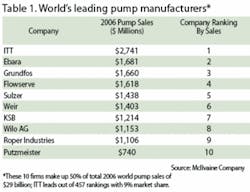There’s Still Money to be Made in Water
by Jim Lucas
This article’s headline holds true on two fronts. First, from an operator standpoint, those companies providing technological solutions stand to profit by solving needs of those countries worldwide with limited access to clean water. The other area that holds true is with investors searching for places to put money to work.
It seems every 4-5 years for two decades, there has been some form of consolidation within the loosely-defined, highly fragmented “water” industry. There remain many investment vehicles to make a “water” play, as evidenced by an emergence in a number of exchange-traded funds (ETFs) and several well-managed companies investing in the sector.
Most notably, companies such as GE and Siemens have garnered their fair share of headlines over several years through a multitude of acquisitions that help customers solve their needs by offering solutions to provide clean water. More specifically, as desalination has become a more viable alternative from a cost standpoint, the amount of activity (especially in the Middle East) has dramatically accelerated.
Within the U.S. equity market, which is where our principal focus is, investors continue to clamor for “water” plays, which are few and far between. The ETFs that have emerged are chasing the same stocks whether it’s utilities, technology providers or even pump makers.
It’s a lot easier to get excited about areas such as filtration or desalination because of the technology involved – but, at the end of the day, pumps are always needed to move water from the source to treatment or discharge. While water scarcity is generally an area that gets a lot of attention, it’s important to not lose sight of the energy required to move water. Desalination projects will get the focus because of their high levels of energy consumption, but pumping stations (both water and wastewater) consume large amounts of energy.
The pump market is highly fragmented, with over 457 pump companies participating in a $29 billion market that continues to grow (albeit not at the higher growth rates often associated with filtration or desalination). The top 10 pump companies represent nearly half the market, and one Chinese and one Indian company have emerged in the top 30. Beyond water applications, pumps are found in virtually every manufacturing industry and the opportunities to consolidate across various end markets will likely be an area of investment for many years to come.
With specific regard to water, investors thirst for new investment ideas. While we have colleagues that focus on the regulated utility side of the business, our coverage tends to be on the equipment side. It has mostly been diversified industrial companies (Danaher, ITT, GE, Siemens, 3M) pulling in headlines of late, but there are a variety of companies likely to continue investing in the space (Pentair and Toro to just name a couple). Water management is the new buzzword entering the vernacular, and there will likely be investment and acquisition opportunities for many companies as this topic gains more attention.
About the Author: Jim Lucas is a managing director at Janney Montgomery Scott LLC, a Philadelphia-based investment firm that just celebrated its 175th anniversary. Lucas focuses on multi-industry companies with recurring areas of focus including infrastructure, water, aerospace, energy and healthcare. The company will host its inaugural Water Industry Summit in New York on April 7-8. Contact: 800-526-6397 or [email protected]

